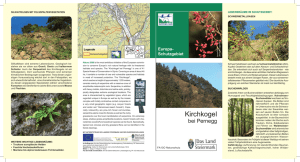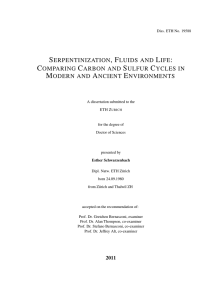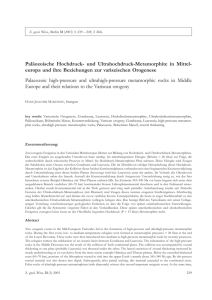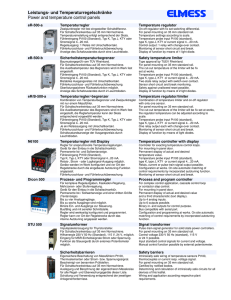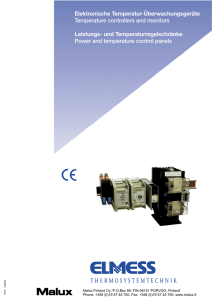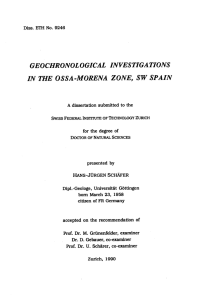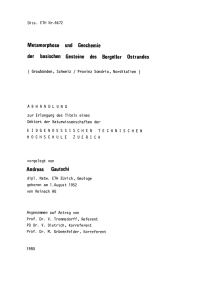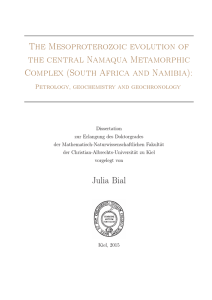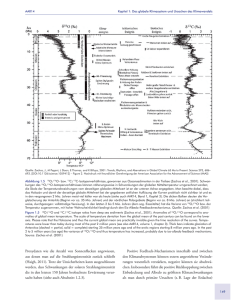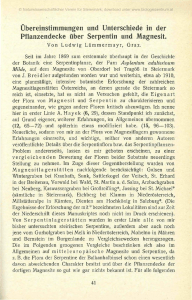Abstract - ETH E
Werbung
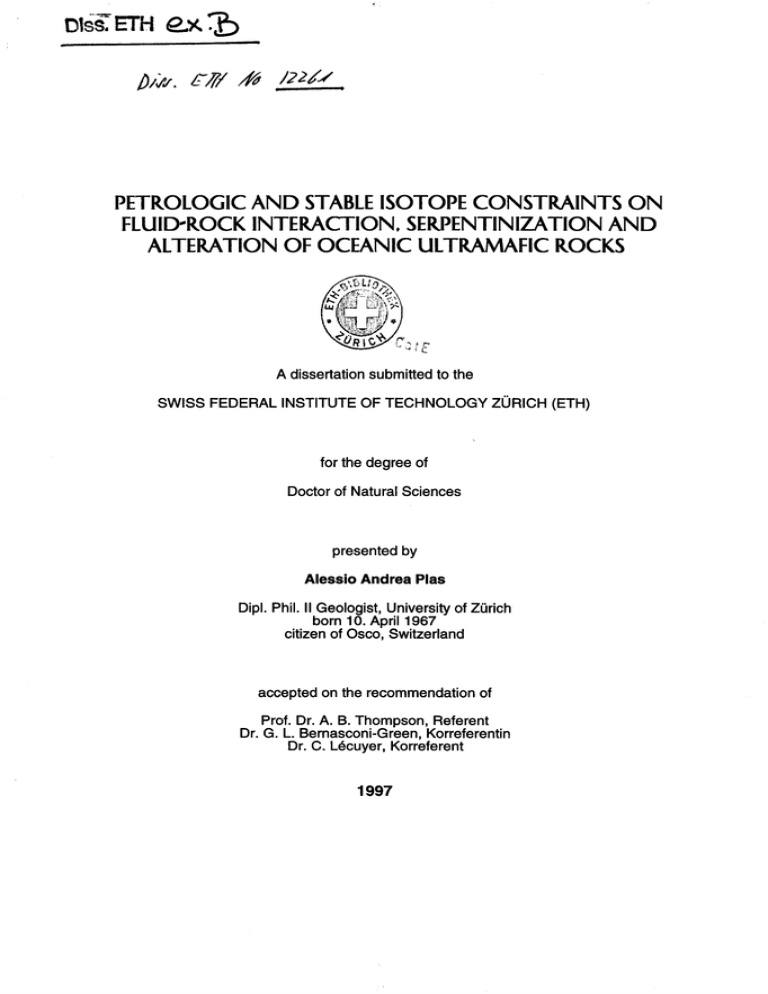
DlsiTETH £X ^) 0/W. fW /fc ft*sy PETROLOGIC AND STABLE ISOTOPE CONSTRAINTS ON FLUID-ROCK INTERACTION, SERPENTINIZATION AND ALTERATION OF OCEANIC ULTRAMAFIC ROCKS A dissertation submitted to the SWISS FEDERAL INSTITUTE OF TECHNOLOGY ZURICH for the degree of Doctor of Natural Sciences presented by Alessio Andrea Plas Dipl. Phil. II Geologist, University April 1967 of Zurich born 10. citizen of Osco, Switzerland accepted on the recommendation of Prof. Dr. A. B. Thompson, Referent Dr. G. L. Bemasconi-Green, Korreferentin Dr. C. L6cuyer, Korreferent 1997 (ETH) ~ ABSTRACT - study is to constrain the mechanisms and effects of fluid-rock interaction and metamorphism of ultramafic rocks. Detailed petrologic and stable isotope investigations were performed on oceanic ultramafic rocks recovered during ODP legs in the Hess Deep Valley (Pacific Ocean, Leg 147), in the Tyrrhenian Sea (Leg107), and on the Iberia Abyssal Plain (Leg 149). In addition, a large number of experiments were performed in order to calibrate a singlemineral oxygen isotope serpentine geothermometer. The aim of this oceanic highly serpentinized sequence of dunites, harzburgites, troctolitic and gabbroic rocks Deep (ODP Leg 147) represent a young shallow mantle section formed at the East Pacific Rise at a fast spreading ridge. The pervasive secondary replacement is dominated by lizardite, brucite, chrysotile, taenite (a FeNi-alloy, documented for the first time in ocean floor serpentinites), antigorite, magnetite, tremolite, talc, chlorite, and iowaite. Static serpentinization formed a typical mesh-textured pseudomorphic replacement of olivine and occurred at unusually high temperatures (>400°C). Lizardite, brucite and taenite progressively replace olivine in a first stage of serpentinization under strongly reducing conditions. Phase equilibria in the FeNi-alloy system indicate that taenite formed at a minimum temperature of 450°C. After (local) complete replacement of olivine and an increase in oxygen fugacity, brucite was partially replaced by chrysotile and taenite by magnetite. The presence of antigorite confirms the high temperature nature of serpentinization. Serpentine has relatively high CI contents, which is probably present as a Fe-rich phase having the composition Fe2(OH)3CI. 8180-values of serpentine are low (from 2.2 to 5.4%o), reflecting high temperature fluid-rock isotopic exchange. Serpentine-magnetite oxygen isotope thermometry yields temperatures between 350 and 545°C. Hydrogen isotope ratios of serpentine are also low, ranging from -69 to -59%o. The metamorphic evolution of the lower crust/upper mantle oceanic sequence is characterised by early near-axis fluid infiltration in the mafic rocks, with subsequent pervasive off-axis metamorphism under upper greenschist-facies conditions. A passive role of serpentinization is indicated by the low degree of deformation of the secondary phases. The results of this study suggest that serpentinization of peridotites at high temperature may be an important contribution to the overall 180-budget in the oceanic lithosphere. The recovered at Hess Leg 107 in the Tyrrhenian Basin, a back-arc basin represent highly depleted, highly serpentinized upper mantle material. Secondary mineralogy is dominated by serpentine (lizardite/chrysotile), early amphibole (mainly tremolite to Mg-homblende), talc and chlorite. Replacement of olivine formed a typical mesh-texture. CI is partitioned into an Fe-rich and Si02-poor phase (possibly Fe2(0H)3CI). The 8180-values of serpentine range from 3 to 7.9%o, with 8D-values ranging from -51 to -62%o. The oxygen isotope ratios of talc and amphibole (respectively 5%o and 4.9%o on average) allow an estimate of the evolution of the isotopic composition of the fluid during metamorphism. The oxygen composition of the fluid was strongly positive during all stages of metamorphism. Five different stages of metamorphism under decreasing temperature conditions are recognised: 1. early hydration at temperatures higher than 650°C by a magmatic or slab-derived fluid source, forming amphibole and followed by deformation caused by emplacement of the body to crustal levels; 2. metamorphism at temperatures of 450-650°C forming talc and chlorite from magmaticor metamorphic-derived fluids; 3. limited fluid-rock interaction between 450°C and 350°C; 4. massive fluid infiltration and pervasive serpentinization under lower greenschist-facies conditions, at temperatures of approximately 300°C; 5. brittle deformation at low temperature, producing late crosscutting veins. The peridotites drilled related to a at Site 651 of ODP subduction zone, zone of the passive margin at the Iberia Abyssal during ODP Leg 149. Primary mineralogy of ultramafic rocks consists of olivine, orthopyroxene, clinopyroxene, spinel and plagioclase. These phases are pervasively replaced by serpentine (lizardite and chrysotile), magnetite, brucite, calcite, clay, tremolite, chlorite, iowaite, and pyrite. Talc and antigorite are absent. Serpentine formed a mesh-textured pseudomorphic replacement of olivine, which is locally strongly sheared. Brecciation, calcitization and alteration by clay minerals are locally intense. Serpentine chemistry is similar to the chemistry of serpentinites from Legs 147 and 107. Chlorine contents the serpentines are relatively high. Stable isotope ratios of serpentine range from 5.3 to 9.3%o and are 180-enriched compared to primary mantle values. 8D-values are very negative, ranging from -75 to -66%o. Serpentine-magnetite oxygen isotope thermometry yields a serpentinization temperature of approximately 150°C. 8180values of clay minerals reflect equilibration at temperatures of less than 50°C. The metamorphic Five sites Plain were along the ocean-continent transition drilled by subsolidus equilibration of websterites in the plagioclase-peridotite stability field, high temperature deformation forming mylonitic shear bands in the websterites, and formation of tremolite due to metasomatic activity. This stage was followed by massive serpentinization of the rocks at approximately 150°C and localised shearing, low temperature brittle deformation causing brecciation and allowing local massive calcitization, and finally alteration by clays at less than 50°C. evolution is characterised serpentinites considered in this study show the following similarities: a high degree of secondary replacement; serpentine chemistry characterised by low Al and high CI and B contents; strongly negative 8Dserpentine; and positive 818Osernentinizing fluid- Tne main differences are: serpentinization temperature; presence or absence of taenite, talc and antigorite; 818Oserpentine; degree and type of deformation; and degree of alteration after serpentinization. Amphibole and talc can be produced at temperatures higher than 500°C during early fluid-rock interaction. However, replacement of primary phases at this stage is limited and in contrast with the massive hydration caused by serpentinization. The role of serpentinization in the emplacement of ultramafic bodies may be active or passive, depending on the tectonic setting. Shearing of the serpentinite texture is not only indicative of diapirism, but may be caused by large-scale tectonic processes, particularly in rifted passive margins. The calculated negative SDfyd values for all samples considered in this study are either an artifact of uncertainties in the presently available serpentine-water fractionation factors or reflect processes occurring during hydrothermal circulation and alteration. These processes are: a) production of methane and/or molecular hydrogen in hydrothermal fluids caused by reactions of serpentine formation, resulting in extremely D-depleted CH4 and H2; b) phase separation, producing various degrees of D-depletion in brines; c) pressure dependence on the hydrogen fractionation factors of minerals. Despite the large volumes of fluid required for serpentinization, local gradients in the hydrogen isotopic signatures of the serpentines suggest a lack of true open system conditions and indicate that the isotopic composition of the fluid was not buffered. Inferred serpentinization temperatures vary from 150° to higher than 400°C. The extremely high T-values at Hess Deep reflect the tectonic setting (rapidly rifted, very young crust produced at a fast spreading ridge) and furnish new limits for the hydration of ultramafic rocks in oceanic environments. Although the presence of antigorite in oceanic samples is an indication of high temperature, its absence can not be considered an indication of low serpentinization temperatures. Mantle sections exposed at the ocean floor are mostly highly serpentinized. As a consequence, through the formation of magnetite, these rocks may play an important role in the production of marine magnetic anomalies. All Boron contents were measured by Secondary Ion Mass Spectrometry (SIMS) in five oceanic serpentinites from different tectonic settings. Boron concentrations in serpentine are very high, ranging from 30 to 160 ppm. Brucite and clay minerals may adsorb higher quantities of boron than serpentine itself, contributing to an increase in total B contents in altered mantle rocks. The results of this study differ with previous studies and the assumption that boron is principally adsorbed by serpentine after the serpentinization process. The primary adsorption of boron is a direct process occurring during the formation of serpentine. Boron contents in oceanic serpentinites are not directly a function of the formation temperatures of the rocks (as assumed to date), but most likely are dependent on boron contents of the fluids and/or fluid/rock ratios during the hydration of the rocks. Consequently, boron concentrations alone can not be used as precise tracers for very low temperature fluid-rock interaction (i.e. "oceanic weathering"). intracrystalline fractionation of oxygen isotopes in serpentine may be a useful method for the serpentinization temperatures, especially in oceanic environments. A large number of experiments were conducted in order to: determine which technical procedure yields the best results; constrain the effects of experimental conditions on the results; and design a useful fractionation curve. Partial fluorination at low temperatures is an inadequate method for the determination of the internal fractionation. In contrast, the thermal dehydroxylation method offers a simple way to determine the intracrystalline oxygen isotope fractionation of serpentine minerals. The extraction of structural water must be performed under ideal conditions (heating rate >350°C/min, dehydroxylation temperature 900-1000°C, maximal grain size of the mineral powders =1u.m). The following fractionation curve has been calculated using natural samples, and piston cylinder re-equilibration experiments: AnonOH-mineral(%°) 4.60-IO6/!2 2.89. The estimation of = - In summary, this study presents new detailed isotopic, chemical, and petrologic data on oceanic serpentinites, as well as new limits for water-rock interaction and serpentinization of the oceanic mantle. The experimental work on the intracrystalline isotopic fractionation in serpentine furnishes a solid data base for similar studies on other minerals. ~ ZUSAMMENFASSUNG - Der Zweck dieser Arbeit war das Studium von Prozessen und Auswirkungen, die bei der Wechselwirkung von Fluiden und Gesteinen am Meeresboden auftreten (ozeanische Metamorphose). Detaillierte petrologische und stabile Isotopen-Untersuchungen von ozeanischen, ultramafischen Gesteinen wurden durchgefuhrt. Ein zusatzliches Kapitel dieser Arbeit widmet sich der Bestimmung der intrakristallinen Fraktionierung von Sauerstoff-isotopen im Mineral Serpentin. Sequenz serpentinisierten Duniten, Harzburgiten, troktolitischen und gabbroischen Gesteinen, Deep" (Bohrkampagne 147) gebohrt wurden, stellt eine Sektion junges Mantels dar, die beim raschen Ausbreitungszentrum "East Pacific Rise" gebildet wurde. Die sekundare Mineralassoziation ist von Lizardit, Bruzit, Chrysotil, Taenit (eine Eisen-Nickel Legierung, die erstmals in ozeanischen Serpentiniten dokumentiert wird), Antigorit, Magnetit, Tremolit, Talk, Chlorit und Iowaite dominiert. Die statische Serpentinisierung, die bei ungewonlich hoher Temperatur (400°C und mehr) stattfand, bildete eine typische Maschenstruktur. Aus der progressiven Ersetzung Die die bei "Hess von Olivin, enstanden in einer ersten Phase Lizardit, Bruzit und Taenit bei sehr reduzierenden System der Eisen-Nickel Legierungen zeigen, dass Taenit Bedingungen. Phasen-Gleichgewichte Temperatur von 450°C entstand. Nach (lokalen) kompletten Ersetzung von Olivin, nahm die Sauerstofffugazitat drastisch zu, Bruzit wurde partiell von Chrysotil und Taenit partiell durch Magnetit ersetzt. Die Anwesenheit von Antigorit bestatigt die hohe Temperatur der Serpentinisierung. Die Serpentinchemie ist durch relativ hohe Chlorkonzentrationen charakterisiert. Dieses Element ist sehr wahrscheinlich in Form einer eisenreichen und siliziumarmen Ausfallung anwesend, die moglicherweise die Zusammensetzung Fe2(OH)3CI hat. Die 8180-Werte von Serpentin sind sehr tief (von 2.2 bis 5.4 permil) und wiederspiegeln den isotopischen Austausch bei hoher Temperatur. Sauerstoffisotopen Serpentin-Magnetit Thermometrie liefert Temperaturen von 350 bis 545°C. Die Wasserstoffisotopen-Signatur von Serpentin ist mit Werten von -69 bis -59 permil, sehr tief. Die metamorphische Entwicklung der ganzen Sequenz, ist durch fruhe Infiltration von Flussigkiten in mafischen Gesteinen in der Nahe des Ruckens, und darauffolgenden, intensiven "off axis" Metamorphose bei Grunschieferfazies-Bedingungen in beiden mafischen und ultramafischen Gesteinen charakterisiert. Der tiefe Deformationsgrad der sekundaren Mineralien ist ein Indiz dafur, dass die Serpentinisierung eine passive Rolle spielte (kein Diapirismus). Die Resultate dieser Studie zeigen, dass die Serpentinisierung vom ozeanischem Mantel eine wichtige Rolle bei der Erhaltung des 1 ^-Budgets der Ozeane spielen konnte. im bei einer minimalen Die Bohrkampagne 107 des ODPs fand am Tyrrhenischen Meer statt, wo hoch-serpentinisierten, hoch-abgereicherten oberen Mantel gebohrt wurde. Die sekundare Mineralassoziation ist von folgenden Mineralien dominiert: Serpentin, Amphibol, Talk and Chlorit. Die Ersetzung von Olivin bildete eine typische Maschenstruktur. Die Serpentinchemie ist durch hohe Chlor Konzentrationen characterisiert. Diese Resultate deuten auf einen anlichen Mechanismus fur die Chloraufnahme, wie in den Proben von Hess Deep. Die 8180-Werte von Serpentin variieren zwischen 3 und 7.9 permil. Die 8D-Werten sind sehr negativ, von -51 bis -62 permil. Die Sauerstoffisotopen-Signatur von Amphibol und Talk (5 und 4.9 permil) erlauben die Abschatzung der isotopischen Zusammensetzung der Flussigkeiten wahrend der Metamorphose, deren Sauerstoffwerte immer stark positiv waren. Funf Metamorphose-Stadien bei abnehmender Temperatur konnten eruiert werden: fruhe Hydratation bei mehr als 650°C, kristallisierte Amphibol von einem magmatischen oder metamorphischen Flussigkeit und wurde von lokalisierter Deformation gefolgt; Metasomatose bei Temperaturen zwischen 450 und 650 °C bildete Talk und Chlorit von magmatischen oder metamorphen Fuide; die Erhaltung grosser Talkmengen zeigt, dass wichtige Hydratation zwischen 350 und 450°C nicht totale Die stattfand; die massive Zufuhr von Wasser bei zirka 300°C verursachte die fast die von spater sproden Deformation gefolgt wurde. Serpentinisierung der Peridotiten, primare Mineralogie von ultramafischen Gesteinen, die bei der Bohrkampagne 149 in der Nahe Uebergangs zwischen Kontinent und Ozean des passiven Kontinentalrands beim Iberischen Flach gebohrt wurden, besteht aus Olivin, Orthopyroxen, Clinopyroxen, Spinell und Plagioklas. Diese sind fast vollstandig von Serpentin (Lizardit und Chrysotil), Magnetit, Bruzit, Calzit, Tonmineralien, Tremolit, Chlorit, Iowaite und Pyrit ersetzt. Talk und Antigorit sind nicht vorhanden. Die Serpentin-Meschstruktur ist lokal durch Scherung deformiert. Brekziation, Kalzitisierung und Alterierung durch Tonmineralien sind lokal sehr massiv. Serpentin ist 180-angereichert gegenuber primitiven Mantelwerten (8180 von 5.3 bis 9.3 permil). Die Wasserstoffwerte sind sehr negativ, von -75 bis -66 permil. Die Serpentinisierung fand bei Zirka 150°C statt. Die 8180-Werte von Tonmineralien wiederspiegeln Equilibrium mit Meeerwasser bei 50°C und tiefer. Die Ausfallung von des erfolgte am Meeresboden, bei weniger als 30-40°C. Die Metamorphose Aufhebung der Peridotiten in verschiedenen Stadien: die Websteriten erlebten erfolgte eine Reequilibration im Subsolidus-Bereich im Plagioklas-Peridotit-Stabilitatsfeld. Hoch-TemperaturDeformation produzierte mylonitische Bander in den Websteriten und wurde gefolgt von metasomatischer Aktivitat und Tremolit Kristallisation. Die massive Serpentinisierung wurde von lokalisierter Scherung begleitet und gefolgt. Schliesslich wurde die Sequenz in geringer Tiefe intensiv durch sprode Deformation brekziert, kalzitisiert und durch Tonmineralien alteriert. karbonatischem Material wahrend der Wichtige Aehnlichkeiten zwischen alien hier betrachteten Serpentiniten sind: der hohe Ersetzungsgrad aller primaren Mineralien, die Serpentinchemie, die stark positiven 8Dserpentin. die positiven 8D-Wert des Fluids. Die Hauptdifferenzen sind: die Temperatur der Serpentinisierung, die Anwesenheit bzw. Abwesenheit von Taenit, Talk und Antigorit, die 8180-Werte von Serpentin, der Deformationsgrad, und die Intensitat der Alteration nach der Serpentinisierung. Amphibol und Talk konnen durch Interaktion mit Fluiden bei Temperaturen von mehr als 500°C gebildet werden. Allerdings, ist die Ersetzung primarer Mineralien wahrend diesem Stadium begrenzt. Dagegen ist die Serpeninisierung meist ein kompletter Prozess, in dem primare Mineralien kaum der massive Hydratation der Gesteine standhalten konnen. Die Serpentinisierung kann eine aktive, sowie eine passive Rolle in der Aufhebung der ultramafischen Kdrpern spielen. Scherung wahrend der Metamorphose muss allerdings nicht unbedingt durch die diapirische Aufhebung eines Korpers verursacht werden, sondern kann, zum Beispiel in passiven Randern, durch grossraumige Scherung entstehen. Die Rekurrenz stark D-abgereicherter isotopischer Signaturen der Flussigkeiten, resultiert aus Ungenauigkeiten der Serpentin-Wasser-Fraktionerungsfaktoren oder von Prozessen, die in Hydrothermalen Flussigkeiten stattfinden. Diese sind: die Produktion von Methan und molekularem Wasserstoff durch Reaktionen der Serpentin-Bildung, die in der Lage sind, extrem Deuterium-abgereicherten CH4 und H2 zu produzieren; Phasentrennung im hydrothermalen System und Entstehung abgereicherter Sole; und Druckabhangigkeit der Fraktionierungsfaktoren von Mineralien. Lokalisierte Gradienten der isotopischen Signatur von Serpentin zeigen, dass trotz der hoher Wasser/Gestein-Verhaltnisse, die reellen Bedingungen eines offenen Systems nicht gegeben sind, und die isotopische Zusammensetzung der Flussigkeiten von der hohen Menge Wasser nicht gepuffert wird. Die berechneten Serpentinisierungstemperaturen variieren zwischen 150 und 400°C und mehr. Die extrem hohen Werte bei Hess Deep wurden durch die tektonische Situation verursacht. Die Anwesenhait von Antigorit in ozeanischen Serpentiniten stellt ein Hinweis fiir hohe Serpentinisierungstemperaturen dar, aber ihre Abwesenheit sollte nicht als Beweis tieferer Werte interpretiert werden. Die Resultate dieser Studie bestatigen, dass Aufschlusse des ozeanichen Mantels hoch serpentinisiert sind. Die Neubildung von Magnetit konnte eine wichtige Rolle bei der Entstehung von ozeanischen magnetischen Anomalien spielen. Borkonzentrationen in Serpentiniten wurden durch sekundare lonen Massenspektrometrie (SIMS) gemessen. Serpentin enthalt hohe Bor-Mengen, von 30 bis 160 ppm. Bruzit und Tonmineralien konnen noch hohere Konzentrationen aufweisen. Die Resultate sind im Kontrast mit der Annahme, Serpentinisierung ins Gestein aufgenommen wird. Die Abhangigkeit zwischen Bildungstemperatur von Serpentin und Bor-lnhalt ist nicht bestatigt. Die Quantitat des aufgenommenen Bors ist sehr wahrscheinlich von der Konzentration dieses Elements in Flussigkeit und vom Massenverhaltniss Flussigkeit/Gestein beeinflusst. Aus diesen Griinden kann die Borkonzentration nicht als Indikator fiir tief-Temperatur Alteration von ultramafischen Gesteine ("oceanic weathering") benutzt werden. dass Bor nach der Experimente wurde durchgefuhrt, urn die intrakristalline Fraktionierung von Serpentin zu bestimmen. Das Ziel dieser Experimente war: bestimmen welche Prozedur die Reproduzierbarkeit liefert, die Charakterisierung der Effekte von technischen und experimentellen Bedingungen auf die Resultate, und die Festlegung einer nutzlichen Fraktionierungskurve, die als Geothermometer angewendet werden kann. Partielle Fluorinierung durch CIF3 kann die erwCinschten Resultate nicht liefern. Thermische Entwasserung im Vakuum stellt eine einfache und effiziente Methode fur die Bestimmung der intrakristallinen Fraktionierung dar. Die Entwasserung der Proben muss bei idealen Bedingungen durchgefuhrt werden: Heizungsrate >350°C/min, Entwasserungstemperatur 900-1000°C, Korngrosse der Proben <1u.m. Eine erste semi-empirische ermittelte Fraktionierungskurve, die als Geothermometer fur ozenischen 4.60-106/T2 2.89 Gesteine angewendet werden kann, lautet: AnonOH-mineral(%°) Eine grosse Anzahl Sauerstoffisotopen im = Dieser Studie stellt - isotopische, chemische und petrologische Daten uber ozeanische Serpentinite Serpentinisierung von ozeanischem Mantel sind beschrieben. Die experimentelle Arbeit uber die intrakristalline Isotopenfraktionierung von Serpentin vor. neue Neue Grenzen fur die bietet eine solide Basis fiir ahnliche Studien von anderen Mineralien.
